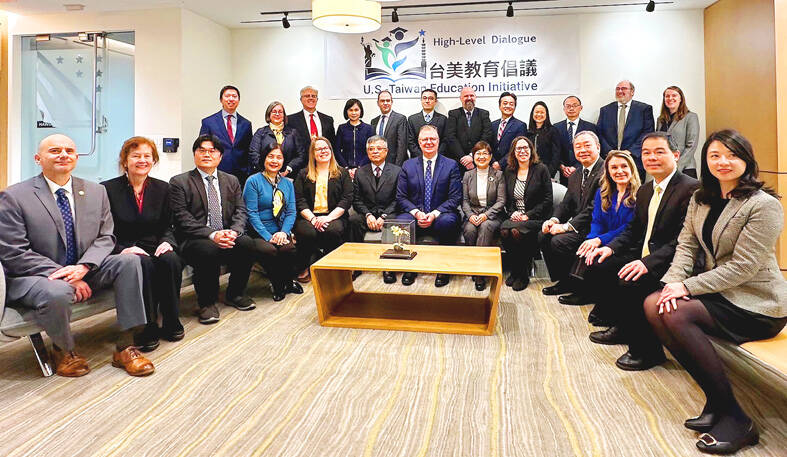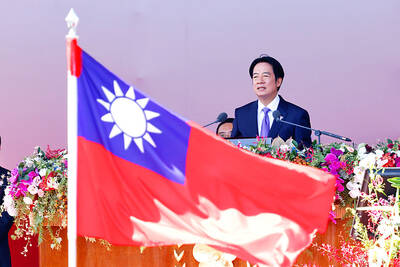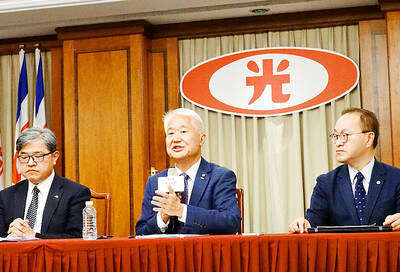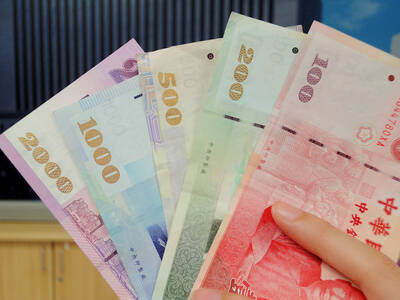Taiwan and the US on Monday reaffirmed their commitment to deepening cooperation in English and Mandarin-language education, with a view to expanding their collaboration to include the sciences.
Deputy Minister of Education Liu Mon-chi (劉孟奇) led a delegation of ministry officials to the fourth high-level dialogue under the Taiwan-US Education Initiative in Washington, the Ministry of Education said in a news release yesterday.
The ministry presented the outcome of bilateral cooperation in Mandarin and bilingual education; exchanges between elementary, junior-high schools and universities; and cultivation of semiconductor talent, it said.

Photo courtesy of the Ministry of Education
Significant progress in promoting Mandarin education has been made since the last dialogue in February last year, Liu said.
A record 3,080 US students are to come to Taiwan to study Mandarin this year, while the ministry selected 147 Mandarin-language teachers and teaching assistants to teach in the US, he said.
Taiwan provided subsidies to 20 universities in Taiwan and 56 universities in the US to promote quality Mandarin education under the Huayu Best (台灣優華語計畫) program, he said, adding that four Taiwan Centers for Mandarin Learning were established last year.
The University Academic Alliance in Taiwan, consisting of 12 universities in Taiwan, has signed memorandums of understanding with three US university systems for cooperation in the fields of semiconductors, engineering sciences and Mandarin-language education, he said.
Thanking the US government for continuing to support bilingual education in Taiwan by sending professional English teachers, the ministry said it hoped that the two nations could extend the cooperation to cover STEM — science, technology, engineering and mathematics — education in elementary and junior-high schools.
Also present at the meeting were National Security Council Deputy Secretary-General Hsu Szu-chien (徐斯儉), who joined online, Overseas Community Affairs Council Minister Hsu Chia-ching (徐佳青) and Representative to the US Alexander Yui (俞大?).
On the US side, attendees included US Assistant Secretary of State for East Asian and Pacific Affairs Daniel Kritenbrink, US Deputy Assistant Secretary of State for East Asian and Pacific Affairs Camille Dawson, American Institute in Taiwan (AIT) Chairwoman Laura Rosenberger and AIT Managing Director for the Washington office Ingrid Larson.
After the meeting, the delegation visited the University of Maryland, a partner in the Huayu Best Program, to discuss with university president Darryll Pines plans to provide Mandarin courses focusing on professional fields to US students coming to Taiwan for internships, the ministry said.
The US-Taiwan Education Initiative was launched in 2020 and was expanded last year to allow more young Americans to learn Mandarin in Taiwan, and more Taiwanese Mandarin instructors to teach in the US, the Ministry of Foreign Affairs said yesterday.
Working with the Foundation for Scholarly Exchange (Fulbright Taiwan), the government is promoting the use of English as the medium of instruction for English-language classes in universities and recruiting more English teaching assistants to meet its Bilingual 2030 policy, it said.

People can preregister to receive their NT$10,000 (US$325) cash distributed from the central government on Nov. 5 after President William Lai (賴清德) yesterday signed the Special Budget for Strengthening Economic, Social and National Security Resilience, the Executive Yuan told a news conference last night. The special budget, passed by the Legislative Yuan on Friday last week with a cash handout budget of NT$236 billion, was officially submitted to the Executive Yuan and the Presidential Office yesterday afternoon. People can register through the official Web site at https://10000.gov.tw to have the funds deposited into their bank accounts, withdraw the funds at automated teller

PEACE AND STABILITY: Maintaining the cross-strait ‘status quo’ has long been the government’s position, the Ministry of Foreign Affairs said Taiwan is committed to maintaining the cross-strait “status quo” and seeks no escalation of tensions, the Ministry of Foreign Affairs (MOFA) said yesterday, rebutting a Time magazine opinion piece that described President William Lai (賴清德) as a “reckless leader.” The article, titled “The US Must Beware of Taiwan’s Reckless Leader,” was written by Lyle Goldstein, director of the Asia Program at the Washington-based Defense Priorities think tank. Goldstein wrote that Taiwan is “the world’s most dangerous flashpoint” amid ongoing conflicts in the Middle East and Russia’s invasion of Ukraine. He said that the situation in the Taiwan Strait has become less stable

CONCESSION: A Shin Kong official said that the firm was ‘willing to contribute’ to the nation, as the move would enable Nvidia Crop to build its headquarters in Taiwan Shin Kong Life Insurance Co (新光人壽) yesterday said it would relinquish land-use rights, or known as surface rights, for two plots in Taipei’s Beitou District (北投), paving the way for Nvidia Corp to expand its office footprint in Taiwan. The insurer said it made the decision “in the interest of the nation’s greater good” and would not seek compensation from taxpayers for potential future losses, calling the move a gesture to resolve a months-long impasse among the insurer, the Taipei City Government and the US chip giant. “The decision was made on the condition that the Taipei City Government reimburses the related

FRESH LOOK: A committee would gather expert and public input on the themes and visual motifs that would appear on the notes, the central bank governor said The central bank has launched a comprehensive redesign of New Taiwan dollar banknotes to enhance anti-counterfeiting measures, improve accessibility and align the bills with global sustainability standards, Governor Yang Chin-long (楊金龍) told a meeting of the legislature’s Finance Committee yesterday. The overhaul would affect all five denominations — NT$100, NT$200, NT$500, NT$1,000 and NT$2,000 notes — but not coins, Yang said. It would be the first major update to the banknotes in 24 years, as the current series, introduced in 2001, has remained in circulation amid rapid advances in printing technology and security standards. “Updating the notes is essential to safeguard the integrity